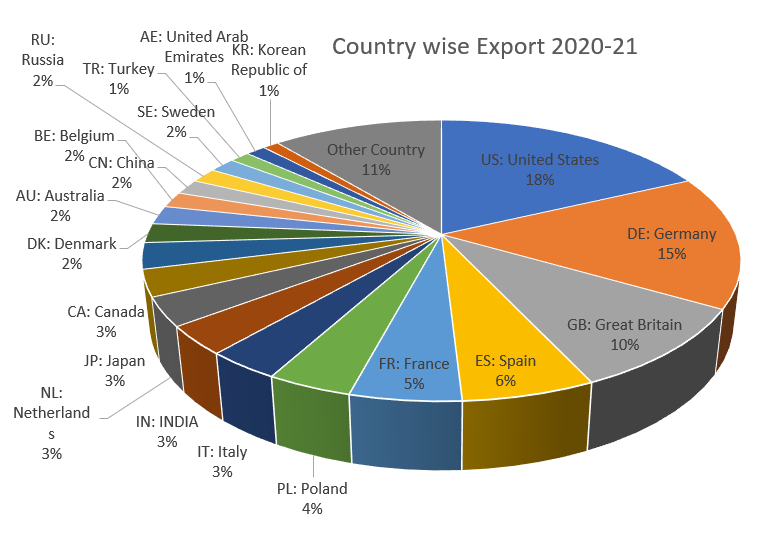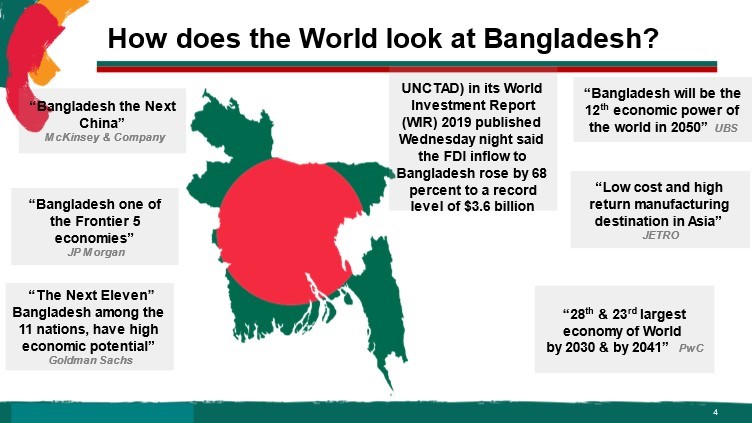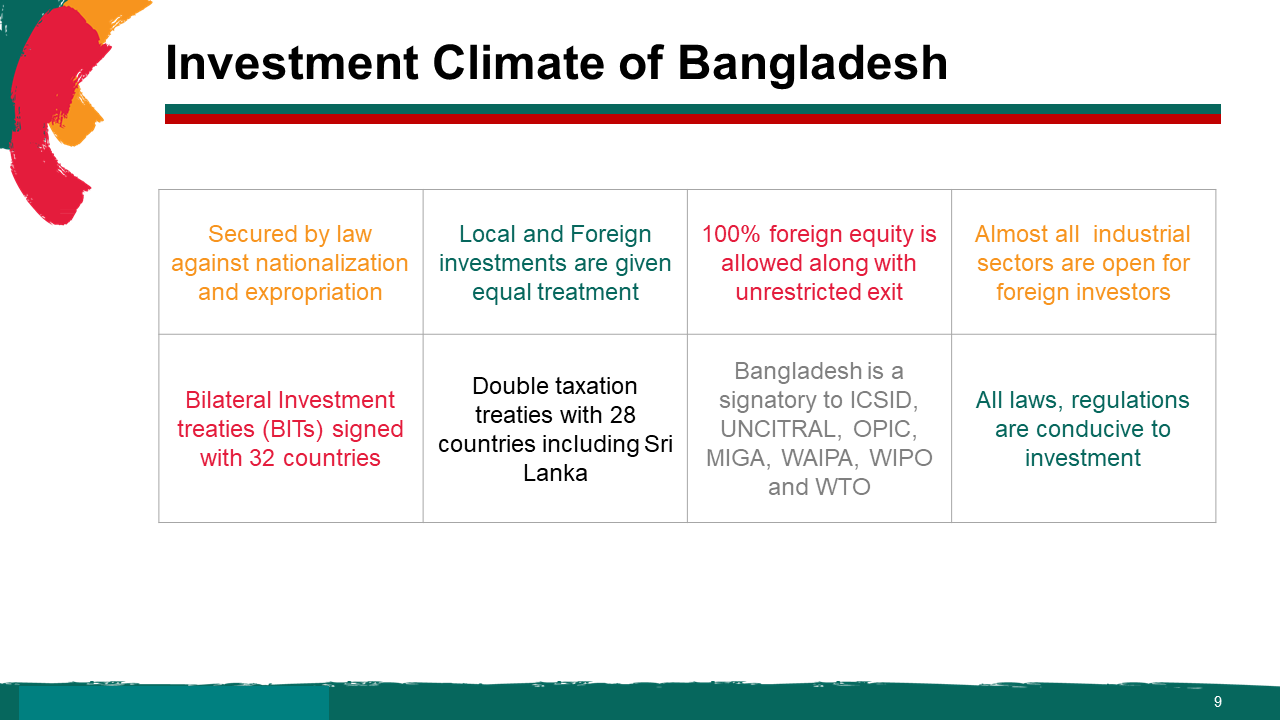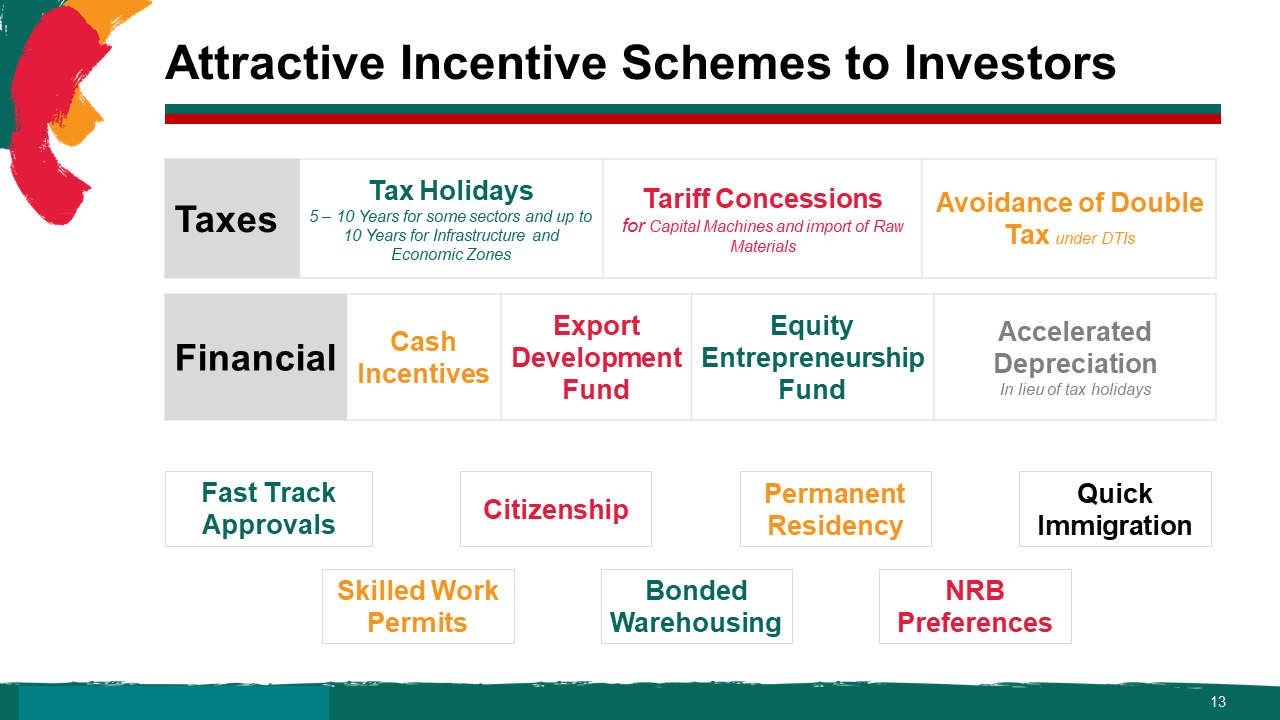Why Bangladesh?
Bangladesh - one of the fastest growing economies of South Asia got her independence in 1971 after the 9-month long Liberation war under the undisputed and unrivalled leadership of the Father of the Nation Bangabandhu Sheikh Mujibur Rahman. Under the dynamic leadership of his able daughter, the Honourable Prime Minister Sheikh Hasina, Bangladesh has made remarkable progress in raising incomes, reducing poverty and improving social indicators and has been classified as a middle-income country by World Bank.
Bangladesh belongs to the largest river delta as well as one of the most fertile regions of the world with a total area of 1,47,570 sq.km. and a coastline of 710 (check) km. It has a population of 166.50 million (Economic Review 2020), making it one of the densely populated countries of the world. Bangladesh is largely ethnically homogeneous. Over 98 percent of the people speak in Bangla. English is widely spoken as well. The country is covered with network of rivers and canals forming a maze of interconnecting channels and rich water ways.
Export Scenario of Bangladesh
Bangladesh exports to 202 countries and territories of the world and the number of products with HS code is 766 (Seven Hundred Sixty-Six). The volume of merchandise and service export in terms of value was 45,367.8 million in the concluding FY 2020-2021. The growth of export is also phenomenal. Due to the fallout of covid like other dominant economies, Bangladesh was also affected but in the FY 2020-2021 Bangladesh rebounded and registered 15.10% growth. The export scenario of Bangladesh indicates her faster moving forward towards Middle Income Country by 2024.
Trend in Export Trade
| 1972-73 | 2020-21 | |
| No. of Products | 25 | 751 (H.S. Code 4 digit) |
| No. of Markets | 68 | 203 |
| Export Value | US$ 348.41 M | US$ 45,367.8 M |
Export from Bangladesh 1972-73 to 2020-21

National Export Earning of Bangladesh from Goods & Service Sector:
A statement of comparative year-wise export earnings for 8 year is given below:
(Value in million US$)
| FY | Export Earnings | Total | Growth (%) | |
|---|---|---|---|---|
| Goods | Service | |||
| 2012-13 | 27027.36 | 2936.30 | 29963.66 | |
| 2013-14 | 30186.62 | 3243.88 | 33430.50 | 11.57 |
| 2014-15 | 31208.94 | 3210.85 | 34419.79 | 2.96 |
| 2015-16 | 34257.18 | 3494.90 | 37752.08 | 9.68 |
| 2016-17 | 34846.84 | 3653.71 | 38500.55 | 1.98 |
| 2017-18 | 36668.17 | 4586.31 | 41254.48 | 7.15 |
| 2018-19 | 40535.04 | 6492.68 | 47027.72 | 13.99 |
| 2019-20 | 33674.09 | 6081.18 | 39755.27 | -15.46 |
| 2020-21 | 38758.31 | 6608.88 | 45367.19 | 14.12 |

Major Exportable of Bangladesh
Apparel is the prime exportable of Bangladesh and contributing around 84% to the total export earnings. Product-wise export performance is furnished below for greater look:
| Commodities | 2016-17 | 2017-18 | 2018-19 | 2019-20 | 2020-21 |
|---|---|---|---|---|---|
| Frozen & Live Fish | 526.45 | 508.43 | 500.40 | 456.15 | 574.00 |
| Agricultural product | 553.17 | 673.70 | 908.96 | 862.06 | 1028.14 |
| Special Textiles | 106.14 | 110.04 | 143.93 | 116.04 | 130.90 |
| Petroleum bi-products | 243.77 | 33.70 | 203.74 | 23.48 | 23.33 |
| Chemical products | 139.99 | 150.72 | 205.18 | 198.86 | 280.58 |
| Leather & Leather Products | 1234.00 | 1085.51 | 1019.78 | 797.60 | 941.67 |
| Raw jute | 167.84 | 155.68 | 112.48 | 129.89 | 138.15 |
| Jute goods | 794.58 | 869.87 | 703.79 | 752.46 | 1023.33 |
| Handicrafts | 14.48 | 16.69 | 19.95 | 20.52 | 33.97 |
| Knitwear | 13757.25 | 15188.51 | 16888.54 | 13908.00 | 16960.03 |
| Woven garments | 14392.59 | 15426.25 | 17244.73 | 14041.19 | 14496.70 |
| Eng. Products (without Bi-Cycle) | 688.84 | 270.23 | 257.06 | 210.08 | 398.11 |
| Home Textile | 799.14 | 878.68 | 851.72 | 758.91 | 1132.03 |
| Footwear (Without Leather) | 240.88 | 244.09 | 271.53 | 277.13 | 344.46 |
| Bi-Cycle | 82.46 | 85.73 | 84.24 | 82.84 | 130.89 |
| Cotton & Cotton (fabrics, Yarn, Waste Etc) | 109.49 | 124.85 | 152.16 | 133.56 | 154.29 |
| Ceramic Products | 39.14 | 51.94 | 68.97 | 27.97 | 31.11 |
| Other mfd. goods | 229.81 | 211.62 | 254.61 | 274.63 | 324.18 |
| Other | 535.88 | 399.92 | 418.25 | 602.72 | 612.44 |
| Total Export: | 34846.84 | 36668.17 | 40535.04 | 33674.09 | 38758.31 |


EXPORT (GOODS) AS A PERCENTAGE TO IMPORT:
Value in million US$)
| FY | Exports | Import | Balance | Export as a percentage to import |
|---|---|---|---|---|
| 1 | 2 | 3 | 4 | 5 |
| 1989-90 | 1524 | 3759 | -2235 | 40.54% |
| 1990-91 | 1718 | 3511 | -1793 | 48.93% |
| 1991-92 | 1994 | 3466 | -1472 | 57.53% |
| 1992-93 | 2383 | 3986 | -1603 | 59.78% |
| 1993-94 | 2534 | 4191 | -1657 | 60.46% |
| 1994-95 | 3473 | 5834 | -2361 | 59.53% |
| 1995-96 | 3882 | 6827 | -2945 | 56.86% |
| 1996-97 | 4418 | 7150 | -2732 | 61.79% |
| 1997-98 | 5161 | 7545 | -2384 | 68.40% |
| 1998-99 | 5313 | 8006 | -2693 | 66.36% |
| 1999-00 | 5752 | 8403 | -2651 | 68.45% |
| 2000-01 | 6467 | 9363 | -2896 | 69.07% |
| 2001-02 | 5986 | 8540 | -2554 | 70.09% |
| 2002-03 | 6548 | 9658 | -3110 | 67.80% |
| 2003-04 | 7603 | 10903 | -3300 | 69.73% |
| 2004-05 | 8655 | 13147 | -4492 | 65.83% |
| 2005-06 | 10526 | 14746 | -4220 | 71.38% |
| 2006-07 | 12178 | 17157 | -4979 | 70.98% |
| 2007-08 | 14110 | 21629 | -7519 | 65.24% |
| 2008-09 | 15565 | 22507 | -6942 | 69.16% |
| 2009-10 | 16204.65 | 23738.00 | -7533.35 | 68.26% |
| 2010-11 | 22928.22 | 33657.40 | -10729.18 | 68.12% |
| 2011-12 | 24301.90 | 35516.30 | -11214.4 | 68.42% |
| 2012-13 | 27027.36 | 33969.00 | -6941.64 | 79.56% |
| 2013-14 | 30186.62 | 40692.90 | -10506.28 | 74.18% |
| 2014-15 | 31208.94 | 40638.50 | -9429.56 | 76.80% |
| 2015-16 | 34257.18 | 40097.40 | -5840.22 | 85.43% |
| 2016-17 | 34846.84 | 43663.00 | -8816.16 | 79.81% |
| 2017-18 | 36668.17 | 52953.40 | -16284.83 | 69.72% |
| 2018-19 | 40535.04 | 55956.50 | -15421.46 | 72.44% |
| 2019-20 | 33674.09 | 48699.80 | -15025.71 | 69.15% |
| 2020-21 | 45367.19 | 60681.00 | -15313.81 | 74.76% |

Top Twenty Country Wise Comparative Export
During July-June 2020-21 & 2019-20
| Countries | Export July- June 2020-21 | Export July- June 2019-20 | Growth (%) |
|---|---|---|---|
| US: United States | 6974.01 | 5832.39 | 19.57 |
| DE: Germany | 5953.51 | 5099.19 | 16.75 |
| GB: Great Britain | 3751.27 | 3453.88 | 8.61 |
| ES: Spain | 2343.99 | 2189.03 | 7.08 |
| FR: France | 1962.14 | 1703.58 | 15.18 |
| PL: Poland | 1503.64 | 1164.25 | 29.15 |
| IT: Italy | 1308.62 | 1282.81 | 2.01 |
| IN: INDIA | 1279.67 | 1096.38 | 16.72 |
| NL: Netherlands | 1277.44 | 1098.68 | 16.27 |
| JP: Japan | 1183.64 | 1200.78 | -1.43 |
| CA: Canada | 1164.01 | 1000.49 | 16.34 |
| DK: Denmark | 861.78 | 649.75 | 32.63 |
| AU: Australia | 834.05 | 678.19 | 22.98 |
| BE: Belgium | 704.98 | 723.43 | -2.55 |
| CN: China | 680.66 | 600.11 | 13.42 |
| RU: Russia | 665.32 | 487.29 | 36.53 |
| SE: Sweden | 656.12 | 584.39 | 12.27 |
| TR: Turkey | 499.79 | 453.46 | 10.22 |
| AE: United Arab Emirates | 495.85 | 294.91 | 68.14 |
| KR: Korean Republic of | 398.67 | 352.82 | 13.00 |
| Other Country | 4259.15 | 3728.28 | 14.24 |
| Total | 38758.31 | 33674.09 | 15.10 |

Preferential Market Access for Bangladesh
- 39 countries including EU countries, Australia, New Zealand, Japan, Norway, Switzerland & Canada -under GSP scheme
- China on 8256 products ( 97% of Bangladeshi Products)
- South Korea on 4802 products
- Thailand on 6998 products
- India on all products except tobacco and drugs under SAFTA scheme
- Malaysia on 525 products
- Chile on all products except wheat, wheat flour and sugar
- SAARC countries on some products under SAFTA/SAPTA
- AFTA scheme
- Bangladesh as LDC enjoys duty free market
13 Highest Priority Sectors
(as per Export Policy 2018-2021)
(Exportable with special export potentials, but such potentials could not be utilized property due to certain constraints.)
- High end readymade garments denim and garments accessories
- Software & IT enable Services, ICT products
- Pharmaceutical Products
- Plastic products
- Leather (Leather, Non-Leather & Synthetic) Products
- Jute goods
- Agro-products & and Agro-processing products
- Ship and Oceangoing Fishing Trawler
- Furniture Industry
- Home textiles & Terry Towel
- Home furnishing
- Luggage.
- Active Pharmaceutical ingredients (API) and Laboratory Reagent
19 Special Development Sector
(Potential sectors with strong production & supply base)
- Jute diversified products;
- Electric and Electronic products;
- Ceramic products;
- Light engineering products including auto-parts & bicycles;
- Value added Frozen fish;
- Papadum;
- Printing & Packaging;
- Rough & Polished Diamond & jewelry;
- Paper & paper products;
- Rubber;
- Silk products;
- Handicrafts;
- Handloom products including Lungi; and
- Coconut coir.
- photovoltaic modules
- Peanut (Raw and Processed)
- Live and Processed Crabs
- Toys
- Agar
Special Development Service Sectors are
- Tourism
- Architecture, Engineering and Consultancy Services
Strength of Our Exportables
Apparel Sector ( Growing Green)
- Second Largest Apparel Exporter in the World.
- 6,500 Garment Factories.
- 7 out of world’s top-most 10 green factories are situated in Bangladesh.
- 4 million workforces.
- US$ 31,456.73 billion Export Earnings.
- Available Backward linkage Industry.
- Maintaining Compliance Issues;
- High Value-Added Apparel Production is on the Rise.
Jute and Jute Goods
- 2nd largest exporter of the world for Jute and Jute goods.
- Export income is US$ 1161.48 million.
- Environment friendly product.
- Demand for Jute goods is increasing as concern for eco-friendly products are in rise.
- Jute is a natural fiber and biodegradable.
- Bangladesh is in a unique position to take advantage of this growing consumer concern.
- Best Alternative to Synthetic Products.
- Export growth of this sector is 31.63%.
Agro-Based Sector
- 3rd largest export sector with US$ 1028.14 million earnings.
- Bangladesh is gifted with a fertile land.
- Favorable climate for the production of various agricultural products.
- Huge supply of raw materials.
- Cheap labor force.
- Demand of local and export market.
- Strong supply chain.
- Eco-friendly production process.
- Export growth of this sector is 19.27%.
Leather & Leather Products
- One of the potential sectors after apparel
- US$ 941.6 billion export earnings;
- More than 220 tanneries, 2500 footwear making industries and 90 large firms;
- Almost 90% of finished products is being exported;
- Labor Intensive industry (about 7 million employment)
- 25% Export Growth over the last five years;
- ECO Friendly Leather Technology has been introduced;
- 2.52% contribution to total export earning
- Average value addition 85%
- Export growth of this sector is 18.06%.
- Leather will get special focus in the new export policy to reduce dependency on garment, which accounts for more than 84% of Bangladesh's export receipts. Benefits enjoyed by the garments industry will be extended to the leather industry.
Frozen Foods (Shrimps & Fish)
- Supplier of world’s reputed tasty, salty & fresh water Shrimps & Fishes;
- US$ 500.40 million export earning comes from this sector;
- Strictly maintain quality following HACCP & Traceability;
- Exporter of Consumer packets and value-added products;
- 74 EU approved processing plants
- 2,70,000 Hector areas are under shrimp cultivation;
Pharmaceutical Products
- 246 registered companies;
- US$ 169.02 million export;
- Quality & Price Competitive products;
- Good number of products registered with EU, Latin America & African Countries;
- 97% of total domestic demand met from local production;
- Multinational companies exist.
- 200 acres of land has been allocated for building API (Active Pharmaceutical Ingredients) park;
- Exported more than 100 countries in the world;
- Declared Product of the year in 2018;
- WTO/TRIPS has extended the pharma period till 2033 for Bangladesh
- License to produce patent medicine up to 2033;
- Exporting to 107 countries;
- Only LDC in the world to produce generic medicine;
- Export growth of this sector is 24.47%.
Light Engineering Sector
- Bangladesh exports Light Engineering Products to E.U, USA, Middle East, Japan and India;
- Light Engineering sector creates a strong base to expand assembling of the electronic sector;
- Light Engineering Products include Spare Parts of different industries;
- Bicycle, Motor Cycles, Automotive maintenance free sealed batteries, Fancy light fittings, Construction equipment’s, Battery, Voltage stabilizer, Carbon rod, Automobile spares, electronic items, etc.
- About 0.60 million workers are employed in this sector.
Ocean Going Ship Building Industry
- Bangladesh is no longer a ship breaking country, it is now a ship building country;
- Capital as well as labor intensive industry;
- Emerged as an important exporting sector in Bangladesh;
- Shipyards of Bangladesh are capable of making ships of about 10,000 DWT as per international standard;
- Exporting to European Union market and to Pakistan, Mozambique, Singapore & Vietnam;
- Sufficient number of skilled people (Engineers, Architects, Designers) and backward linkage industry are available;
- Shipbuilding, an ancient assembling industry producing tailored products
- Best combination of cost, quality and productivity with fast growing young workforce
Furniture Sector
- Bangladesh declared furniture as a priority sector for expanding export
- Labor intensive and is generating 1.7 million
- Employment directly;
- 70,000 enterprises (both small and large scale) are supporting this cluster;
- Exporting furniture to Japan, Singapore, Australia, USA and other markets;
- Furniture factories are committed to developing design, fine craftsmanship and quality;
- Supplier to Shipbuilding Industry.
ICT Sector
- 39 Hi-Tech Parks and Software Technology Parks and 64 IT training and incubation centers across Bangladesh;
- The government has set a target of 5 billion in export revenue from the ICT sector and employment of 2 million people by the year 2030;
- Bangladesh has been recognized as the 26th best destination for IT out-sourcing globally by leading US companies;
- Over 4500 Software and ITES companies are registered in Bangladesh
- 100 companies exporting software and outsourcing jobs to more than 30 countries;
- Export earning already crossed 1.3 billion US$;
- More than 30 thousand employments are generated from this sector;
- Many developed countries are conducting their business in joint venture with Bangladeshi firms;
- More than 200 IT firms are directly and 800 IT firms are indirectly involved in this sector;
Ceramic and Porcelain Wares
- 100% Halal ingredients
- Competitive price
- ISO Static production system
- Capable to export bulk quantity
- Good reputation around the world
- Lead & Cadmium free glaze and pigments
- GSP if re-export or via agent through Dubai
- Compliant by ISO 9001, Sedex, CTPAT, BSCI etc
- Bangladesh exports Ceramic & Porcelain tableware, Bone China tableware and Stone tableware, Ceramic Tiles, Ceramic Sanitary Ware;
- Skilled Workers, Artisans, Designers are available;
- Export to Europe, U.S.A, Canada, Japan, South Korea, China, India, Singapore, Middle East, Russia, Turkey & other countries
- Bangladesh has got Sulfur-free natural state-owned gas supply
Why Invest in Bangladesh
Bangladesh is one of the fastest growing economies in the world. Its economy has been growing steadily at the rate of above 6.5% on average over a decade and thus has transformed the country into a land of opportunities. It is now being considered as the next Asian Tiger.
Bangladesh offers the most liberal FDI regime in South Asia, allowing 100% foreign equity ownership with unrestricted exit policy. Almost all the sectors are open for foreign investment without any quantitative restrictions. The country offers generous tax holiday, reduced tax rate for specific sectors, bond facility, export incentives, and other fiscal incentives. The country offers the most generous incentive Packages in the South Asian region which include the followings:
- Corporate Tax Holiday from 5 to 10 years in certain areas and sectors
- Accelerated Depreciation on cost of machinery for new industries in lieu of tax holiday
- Bonded warehousing facility for export-oriented industries
- Domestic market sales up to 20% allowed to export-oriented companies outside EPZ
- Cash incentives and export subsidies granted on the FOB values ranging from 5% to 20% on selected products
- Tariff concessions on import of raw materials of the export-oriented industries
- Duty free market access to EU & most developed countries
- 100% foreign equity is allowed
- Full repatriation of dividends and capital is allowed
- Tax exemption of remittance of royalty, technical knowledge and
Consequently, under these circumstances, Bangladesh in comparison to the other south Asian economies, has catalyzed an exceptional investment ambience within the past few years. A superior investment environment is vital for the private sectors to be able to contribute to the global sustainable development agenda in the support of the following facilities prevailing for the investors.
Trade Agreements
Signed memberships and agreements include:
- Bay of Bengal Initiative for Multi-Sectoral Technical and Economic Cooperation (BIMSTEC) Free Trade Area
- Trade Preferential System of the Organization of the Islamic Conference (TPS-OIC)
- Asia-Pacific Trade Agreement (APTA)
- D-8 Preferential Tariff Arrangement
- South Asian Free Trade Area (SAFTA)
- Bangladesh – Bhutan PTA
- Bangladesh is a member of the World Trade Organization
Openness to Foreign Investment
Bangladesh welcomes foreign investment in most sectors and providing favourable conditions for doing business.
Some of the incentives Bangladesh offers to foreign investors are:
- Tax holidays and exemptions
- Simplified import process of raw materials and machinery
- Facilitation of utility connections
- One stop service at Bangladesh Investment Development Authority (BIDA)
- 100% equity participation
- Full repatriation of profit
- Separate Economic and Export processing Zones
- The Bangladesh Economic Zones Authority (BEZA) is working to create 100 economic zones all over the country in the next 15 years.
Furthermore, one of the leading trading partners of Bangladesh has been the EU.
Skilled workforce in Bangladesh
The Skills for Employment Investment Program (SEIP). The SEIP introduced large-scale partnerships with the private sector to scale up the country’s skilling capacity.
Bangladesh’s high growth is often highlighted by the RMG industry, the share of which in total exports surged from 40% in 1990 to 80% by 2015.
It is estimated that women’s employment grew by 4.4% annually due to demand from urban industrial employment, well over twice the rate of growth in the overall working-age population. The majority of the labor force are still engaged in agriculture and allied sectors (41%), while about 20% are employed in the industry sector and 39% in the services sector. But the workforce is diversifying. Bangladesh has a 60 million plus youth force. The government has set up multiple specialized training and skill development centers around the country.
The youth of Bangladesh are ready to seize the opportunities offered by the 21st century, as their potential is being realized in eclectic range of sectors.
Perfect Weather Condition
In Bangladesh, we don’t have extreme temperature changes. We have six seasons: Summer, The Rainy season, Autumn, Late Autumn, Winter and The Spring. But we have over 8 different microclimates that combined with fertile grounds, provide the ideal conditions to grow, process, pack and export some of the best exotic fruits, vegetables and crops for the most demanding palates in the food industry.
Bangladesh: A Treasure of Biodiversity
Bangladesh encompasses only 0.03% of the world’s surface, but is the home of 5% of Earth’s biodiversity. The country has many different kinds of forests, from the dry ones in the southern pacific to the famous rain forests, making it a breathing live lab.
Strategic Location
Located on the border of South and Southeast Asia, Bangladesh is close to other major markets in the region, such as China.
Bangladesh’s capital city Dhaka has easy access to its neighbouring countries. It is also the commercial and financial hub of Bangladesh and the largest economic center of Eastern South Asia.

















